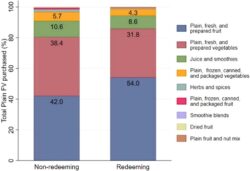Boosting Low-Income Families' Fresh Produce Choices with Supermarket Voucher Expansion

In the United Kingdom, in order to support low income families access healthy food there are government issued ‘Healthy Start Vouchers’ available to low income pregnant mothers or families with young children to support with purchasing healthy foods and milk through the Healthy Start Scheme. In response to the National Food Strategy Independent Review and the cost of living crisis the value of these weekly vouchers were recently increased from £3.10 to £4.25. However, many argue that this value needs to be increased further.
Some retailers have responded by offering users of the Healthy Start scheme further top-up coupons to be spent on fruit and vegetables. In our study we investigate the impact of an additional £2 coupon which they could only use to buy fruits and vegetables, on the shopping baskets of these customers using anonymous loyalty card transaction data.
Transaction and redemption records from 150 loyalty card-holding households, living in the Yorkshire and Humber region of northern England, who had engaged with the top-up scheme, were analysed to assess the potential overall population impact. Using a pre-post study design, 133 of these households' records from 2021 were compared with equivalent time periods in 2019 and 2020.
The study found that during the top-up scheme, each household bought about 0.9 more portions of fruits and vegetables daily compared to what they used to buy in 2019. The percentage of fruits and vegetables in their shopping baskets also increased by 1.6 percentage points. However, the amount of money spent on these foods didn't change.
If a household used the top-up coupons to buy fruits and vegetables, they bought about 0.4% more of these items by spending and 1.6% more by weight compared to households that didn't use the coupon but still bought fruits and vegetables. Also, when households used the coupon, they tended to buy 5.5 more of the types of fruits and vegetables that are recommended for a healthy diet. While fruit and vegetable purchases both increased, purchases of fruits increased most, constituting a higher proportion of the total basket (see figure 1)

Figure1: Proportion of fruit and vegetables (FV) purchased in each households' (n = 150) mean non-redeeming and redeeming baskets. Calculated as a proportion by total weight (kg) purchased for each household. Bold denotes significantly different from non-redeeming. FV, fruit & vegetable; redeeming, Healthy Start voucher top-up redeeming baskets; non-redeeming, non-redeeming baskets.
It is worth noting that the top-up coupons were only used about 9.1% of the time when people bought fruits and vegetables. The top-up coupons were used more frequently in stores in the most deprived areas (see figure 2).

Figure 2: Relationship between deprivation and Healthy Start voucher (HSV) top-up coupon redemption rate for stores within the Yorkshire and the Humber region. Each store was assigned an IMD and IDACI decile. HSV top-up redeeming baskets per store (%) refers to the proportion of HSV top-up redeeming baskets recorded out of all baskets made by the households (n = 150) in each store. IDACI, Income Deprivation affecting children index; IMD, Index of Multiple Deprivation.
This study offers new insights into the shopping habits of low-income households in northern England before, during, and after the COVID-19 pandemic. The data reveals that a program where supermarkets added extra money to government-issued Healthy Start Vouchers specifically for fruits and vegetables led to increased purchases of these items in low-income households that used these top-up coupons.
These findings align with the results of other public health initiatives that show setting aside money for fruit and vegetable purchases can help people in need access these foods and can be valuable for shaping future public health policies aimed at reducing food insecurity and health disparities. However, the adoption of these top-up coupons was relatively low, so it's important to explore ways to encourage more participation in future programs.
In summary, this study shows that setting aside money specifically for fruits and vegetables can make it easier for low-income families to buy and eat these foods. These findings can be useful for policymakers trying to reduce health inequalities among different income groups.
